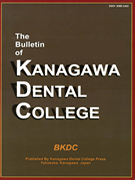- HOME
- > 一般の方
- > バックナンバー:The Bulletin of Kanagawa Dental College
- > 37巻2号
- > アブストラクト
アブストラクト(37巻2号:The Bulletin of Kanagawa Dental College)

English
| Title : | Noninvasive measurements of endothelial vascular function on gingival circulation |
|---|---|
| Subtitle : | Selective Proceedings of 43rd General Meeting of Kanagawa Odontological Society, 2008 |
| Authors : | Shuta Sugiyama*1, Shun-suke Takahashi*1, Chihiro Miyamoto*1, Ayaka Yoshida*1, Kyo Kobayashi*1, Yojiro Maehata*1, Fumihiko Yoshino*1, Satoko Takahashi*1, Kazuo Todoki*2, Masaichi-chang-il Lee*1 |
| Authors(kana) : | |
| Organization : | *1Division of Pharmacology and ESR Laboratories, Department of Clinical Care Medicine, Kanagawa Dental College, *2Division of oral science & pharmacology, Department of Dental Hygiene, Shonan Junior College |
| Journal : | The Bulletin of Kanagawa Dental College |
| Volume : | 37 |
| Number : | 2 |
| Page : | 131-133 |
| Year/Month : | 2009 / 9 |
| Article : | Report |
| Publisher : | Kanagawa Odontological Society |
| Abstract : | [ABSTRACT] In recent years, endothelial function has been estimated by plethysmography, which was verified reactive hyperemia of forearm. The aim of this study was to apply this method for reactive hyperemia of gingival circulation. We also investigated the alteration of peripheral artery resistance of the non-obese diabetes mellitus rat. Gingival blood flow (GBF) was measured by using a laser Doppler flowmetry (LDF) on Wistar rats as control and Goto-Kakizaki rats (GK), which were used as a rodent model for type 2 diabetes. To evaluate the functions of endothelial and smooth muscle, reactive hyperemia was elicited by release of occlusive gingival compression for 1 min after treatment with acethylcholine (ACh) and nitroglycerine (NTG) via gingival mucosa. The reactive hyperemia on gingival circulations were estimated by basal blood flow (basal), maximum response (peak), time taken for the maximum response to fall to one half (T1/2), and increased total amount of blood-flow (mass). As the preliminary results of gingival reactive hyperemia in wistar rats, Peak, T1/2, mass, were significantly increased after treatment with ACh and NTG, suggesting that these parameters would be involvement with vascular function of gingiva. All parameters of gingival reactive hyperemia after treatment with ACh and NTG in GK were significantly decreased as compared to wistar rats. These results suggested that the disruption of oral vascular functions would be associated with type 2 diabetes. Further, it is likely that measuring of reactive hyperemia in the oral microcirculation may estimate vascular endothelial function of general circulation such as plethysmography of forearm. |
| Practice : | Dentistry |
| Keywords : | Diabetes mellitus, Reactive hyperemia, Endothelial function, gingival circulation |
